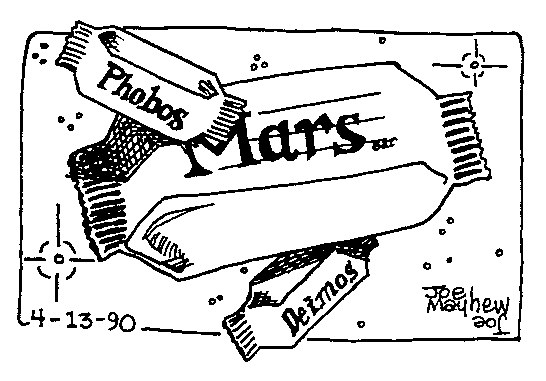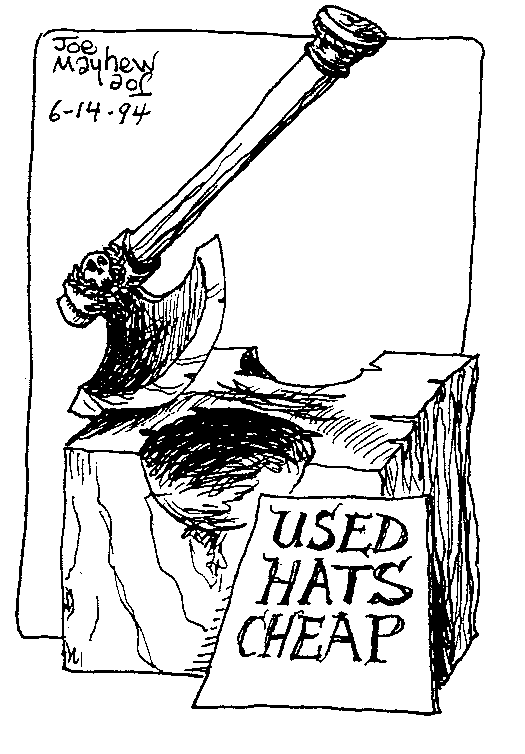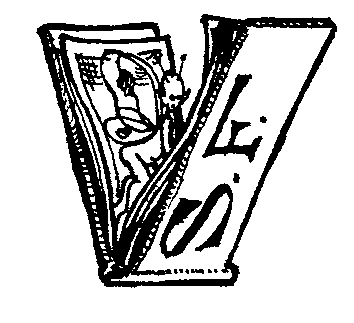

The Official Newsletter of the Washington Science Fiction Association -- ISSN 0894-5411
Edited by Joe Mayhew
(NB: The minutes in the October 6th issue of THE WSFA JOURNAL were actually for the September 15th meeting at Ginter's.)
Attending: Pres. Covert Beach, Sec. Joe Mayhew, Treas. & 96 Chair, Bob MacIntosh, Trust. David Grimm, Trust. John Pomeranz, 97 Chair Mike Nelson, Bernard Bell, Elspeth Burgess, Chris Callahan, Steven desJardins, Chuck Divine, Den Fox, Sharon Fox, Bill Gennetti, Alexis Gilliland, Lee Gilliland, Erica Ginter, Dan Hoey, Chris Holte, Eric Jablow, Bill Jensen, Judy Kindell, Samuel Lubell, Richard Lynch, Nicki Lynch, Keith Marshall, Walter Miles, Peggy Rae Pavlat, Evan Phillips, Dick Roepke, John Sapienza, Tom Schaad, George R. Shaner, Steven Smith, William Squire, Lee Strong, James Uba, Michael J. Walsh, Miles Weissman, Madeleine Yeh, Mike Zipser, Beth Zipser, Ben Zuhl.
President Covert Beach called the meeting to order at 9:16. The election of a Chair for the 1998 Disclave was scheduled for after the meeting. There was no other agenda.
Former Secretary Lee Strong presented his WSFA JOURNAL covering WSFA meetings in November & December, 1994 and for the first Friday in January, 1995.
Treasurer Bob MacIntosh reported a balance of $7,586.78.
John Pomeranz, speaking for WSFA's Trustees announced that their candidate for the Chair of the 1998 Disclave was Joe Mayhew.
DISCLAVE 1996. Bob MacIntosh mentioned a scheduled walk-through of the Hotel for the next Disclave, the Hyatt Regency Washington on Capitol Hill, for the principal space users: Joe Mayhew (Program), Judy Kindell (Art Show), David Grimm (Con Suite), and Mike Nelson (1997 Chair). He also invited whomever would be elected to Chair the 1998 Disclave. A fuller tour would be arranged for the larger committee at a later date.
NO BUSINESS WAS CONDUCTED
ANNOUNCEMENTS: Alexis GIlliland has a story in the current issue of ANALOG and Joe Mayhew has two cartoons in the current issue of ASIMOV'S.
Dan Hoey announced that he intended to run for Chair of the 1998 Disclave.
The meeting was adjourned at 9:26 to be followed by the election of a Chair for Disclave 1998.
Trustees John Pomeranz and David Grimm announced that Joe Mayhew was their candidate for Chair of the 1998 Disclave.
When the floor was opened, Dan Hoey was nominated and seconded, thus requiring a written ballot.
After counting the ballots, the Trustees certified Joe Mayhew as Chair of the 1998 Disclave.


The line between science fiction/fantasy and the mainstream is not as distinct as partisans of either would like to pretend. Many South American magical realism works are published as mainstream yet, if the same author were American, could easily appear as a Tor, Ace or Bantam fantasy novel. Similarly, a novel that is basically a mainstream book with hints of fantasy, written by a fantasy author, is likely to be published as fantasy.
The action in LOVING LITTLE EGYPT by Thomas McMahon (Penguin Contemporary American Fiction) could come out of today's headlines -- or one of the many Hollywood films that have discovered the Internet -- a teenage hacker, with the ability to disrupt communications across the country, is chased by the FBI and big business, and discovers love and a way to turn the tables on his adversaries. But this novel takes place in the 1920s and the hacker is Mouly Vold, a nearly blind child who learns to manipulate the primitive phone system by mimicking the clicks of phone relays. Determined to learn more than he can from the pages of EXPERIMENTS IN ELECTRICITY A BOY CAN DO he escapes from the school for the blind to go learn from Alexander Graham Bell, the inventor of the telephone.
Both Bell and Thomas Edison are major characters in this book, neither presented complimentary. Bell is shown as a tragic figure, one whose ideas and imagination outstrip his scientific abilities. He presents wild ideas -- blowing hostile airplanes out of the sky with giant fans, flying by using the energy of evaporating ice etc., and multinippled sheep -- totally seriously:
"Instead he struggled with his own defective ideas...His ideas for inventions needed a man of extraordinary senses to guide them, senses that he did not possess. Over and over again his imagination took him into scientific fields where he had no competence."
The contrast with the nearly blind Mouly Vold is evident. Similarly, Edison is presented as half deaf, an eccentric who achieved his inventions through trial and error, working himself and his staff half to death. He is presented as stealing ideas from Bell and Nikola Tesla, who in turn is shown as nearly crazy, concerned more for feeding birds than for his own science. This negative attitude toward the great figures of science may be the key element that keeps this book from being genre science fiction.
The descriptions of Mouly on the phone lines, in which he adopts the alias "Little Egypt" are almost cyberpunkish as he learns more and more about how to manipulate the phone system. But the book focuses more on "Little Egypt"'s dilemmas. Should he share his discoveries with his blind friends who share a "party-line" shared switch box that is about to close as the phone company changes to a new system? Or should he warn the phone company of the flaws in this new system? When he makes his choice, he finds himself pursued by the Hearst newspapers which has decided the phone vandal is a Mexican (or Communist) spy, by Thomas Edison, and the police.
McMahon is actually less concerned with this plot, although he does it full justice, than with his characters and the society in which they live in. Bell's guilt at seeing Helen Keller naked, Mourly Vold's mother's attempt to rise back into the upper middle class, the frustration of ex-WWI soldiers back from the war are all portrayed in detail. Much of the book is concerned with Mourly's life on the run, as a bridge painter and farm worker, when he falls in love.
The cover to the Penguin edition is appropriately old fashioned, with historical characters listening on old-fashioned telephones while a larger telephone looms in the background.
John Barth's THE LAST VOYAGE OF SOMEBODY THE SAILOR could have been fantasy but, if so, it is a debunking fantasy, removing the magic behind the Sinbad stories. Or does it? For after all, the central conceit of the novel is that a character from modern times, the travel writer Simon Behler, finds himself in mythical Baghdad at the home of Sinbad the Sailor, right before that worthy's seventh voyage. Literal time travel should be enough to place a book into s/sf. And if that didn't do it, Sinbad's talk of monsters, islands on the back of whales, roc's-egg temples, cannibals etc. (not to mention a literal incarnation of "The Destroyer of Delights and Severer of Societies") certainly should.
Yet the focus of the first half of the novel is not on Sinbad's stories, but on Behler's own life story. Behler, who caught Sinbad's attention by identifying himself as Sinbad the Still Stranded, and Sinbad swap stories. Each night Sinbad tells a fantastical story of one of his voyages to Behler and the other guests and Behler tells one of his "voyages" -- his first time in an airplane as a young boy when he gave up his dream of being a pilot, his first sexual experience recounted in great detail, the collapse of his marriage, and his near-drowning in which he crossed the "Boundary" that put him into Sinbad's Baghdad.
Gradually the two stories intersect once Behler is rescued by Sinbad's ship, sailing with Sinbad's daughter to her promised husband. This story exposes the dirty truth underneath the Sinbad legends as Sinbad, his daughter, his adopted son, and even "Sinbad the Still Stranded" have secrets that become exposed.
One of the most amusing parts are the reactions of Sinbad's other guests to Behler's stories:
"The high ground of traditional realism, brothers, is where I stand! Give me familiar, substantial stuff: rocs and rhinoceri, ifrits and genies and flying carpets, such as we all drank with our mother's milk and shall drink -- Inshallah! -- till our final swallow. Let no outlander imagine that such crazed fabrications as machines that mark the hour or roll themselves down the road will ever take the place of our homely Islamic realism, the very capital of narrative..."
In general, the early Behler "voyages", while rich in character do nothing to advance the Sinbad and his daughter plot. Indeed it is unclear why Barth chose the Sinbad framework to tell the life of Behler until page 394 (Voyage Five) when the two characters' stories finally begin to coincide. I could not see a relationship between the themes in the Sinbad voyages played out as modern equivalents in the Behler ones. However, starting in "Somebody's Fifth Voyage" the questions of Sinbad's daughter's virginity, her sexual relationship with Behler, and her father's last voyage --all of which had been shown in lengthy interludes after the stories of each voyage -- finally moves to the fore.
One key thing that separates this from a genre book is the lack of concern for how Behler found himself in Sinbad's time. He was almost drowned trying to rescue a woman and then woke to find himself back in time without realizing it until everyone starts staring at his watch as if it was a mysterious magical instrument. (However, the author does hint at an acceptable mainstream explanation in the novel's opening and a subsequent description of a novel Behler wrote.)
This can be contrasted with a genre book, Kirk Mitchell's NEVER THE TWAIN which despite a similar theme, a modern person travels back in time to meet someone famous, is clearly marketed as science fiction (and rather lackluster sf at that.) Unlike Behler's accidental voyage, Howard Hart goes back deliberately to prevent Twain's writing career from starting (hence the title) so that his own writing ancestor would become rich and leave lots of money to his descendants. Howard even takes along a manuscript copy of HUCKLEBERRY FINN. The time travel mechanism is scarcely more detailed than that in SOMEBODY and is simply walking through eddies in time, not using a machine (despite the otherwise clever cover illustration of a grandfather clock with old fashioned electrical equipment) The focus here is more on action, the hero gets involved with Confederate spies and tries to reform a prostitute. And there is no comparison in terms of literary quality. Still, it seems strange that a book with a real person like Samuel Clemens is considered fantasy, while one with Sinbad walking out of legends of rocs and whale-islands can be published as mainstream.

Pamela Dean's TAM LIN is marketed as fantasy (from Tor), included as part of the Fairy Tale series, and has a cover of a woman in medieval dress. Yet as a story of three roommates at college in the 1970s, this could easily have been marketed as mainstream. The fantasy elements are low key and not until almost the very end are the characters confronted with something that cannot easily be dismissed or explained.
It is difficult to describe the wonders of the book. Pamela Dean's fantasies frequently use quotes from great writers as spells, here it is literature and the characters' love for it that is the magic illuminating the book. The writing and story are rich in real characters and everyday wonders. It is one of my all-time favorite books.
Reading and books fills the story and the lives of the characters, starting right from the opening which describes how the Greek textbook is used to keep the bookcases up, "The generally harried air of most Classics majors was attributed by their friends and roommates entirely to their reliance on an inferior wedging system for their bookcases." By page three, Dean has mentioned Hermann Hesse, Heinlein's juveniles, and THE WIND IN THE WILLOWS (thrown out the window by a character's mother.) One character brought six boxes of books to college, another examines the books literally in the same sentence she says "Hi". (The third roommate begins to feel stupid because she doesn't read.)
The central character is Janet, an English major, who explains her choice of majors to her roommates as:
"If the thing you liked best to do in the world was read, and someone offered to pay you room and board and give you a liberal-arts degree if you would just read for four years, wouldn't you do it?" "But what will you do after that?" "Go to graduate school and read some more."
By the end of the book anyone who did not major in English - - and many who did -- will be tempted to call their college and ask if it is too late to re-enroll. The characters quote famous poets and playwrights, especially Shakespeare, at the drop of the hat and read poetry out loud for the feel of the sounds. Janet becomes annoyed when the entrance to the college tunnel system has a misquote, "Abandon all hope, ye who enter here", other characters are furious when a performance of Hamlet cuts the Hamlet's melancholy, "Are they mad? Do they want to gut the play? Don't they know that Hamlet must be his own clown?", and even the Fourth Erickson ghost, which may or may not really exist, throws, of all things, books out the windows. In this atmosphere, it seems almost natural that Janet would literally start to relive literature. (As an English major, Janet should know better than to become involved with a guy named Thomas.)
Janet has difficulty getting along with the roommate who doesn't read, their other roommate constantly argues with her boyfriend, but they all stick together and their affection is infectious. The reader cannot help but to grow to like all the characters. There is no real villain.
The plot revolves around the life and loves of the three roommates at college, their courses, and other amusements. In addition to their search for the ghost or whomever is throwing the books out their window (but where do these *old* books come from?), the three begin to date three strange Classics majors with weird moods and mannerisms. By the end of the book these -- and some strange goings on in the Classics department -- are all explained. There clearly is some nostalgia for the author's own college days, and a sense of not getting everything out of the college years.
Key to the book is Janet's relationship to Thomas, who first insults her in the library and then becomes her roommate's boyfriend. Thomas is an eternal undergraduate who keeps switching his major (he announces his retirement from the Classics department by staging a play in which the costumes make fun of the head of the department. Until the end when the fairy tale (actually a Scottish ballad) takes over, this is clearly a book where the plot emerges from the characters rather than manipulating them.
If the last thirty pages of the 460 page novel had been changed only slightly, the rest could have been published as mainstream without changing a word, and probably have garnered more critical attention. This novel is a treat for anyone who likes to read, anyone who struggled to build friendships and relationships, and anyone remembers what was like to choose between homework for a class that really interested you or the company of your friends. This is a book to give to those who say they don't like fantasy or to those who love it. I cannot recommend it highly enough.
This of course hardly exhausts the relationship between sf/fantasy and mainstream. Alternate history, when not presented as the result of time travel or interactions of parallel worlds, would appeal strongly to fans of historical fiction and frequently have no elements of science fiction in them other than the altered historical background. Similarly there are the fantasies without magic like Peake's GORMENGHAST and Kushner's SWORDPOINT which are fantasies because of their atmosphere -- they feel like fantasies -- and because they take place in a setting that never existed (but neither did the county that Faulkner wrote about.) Still, this is enough to demonstrate that the label assigned to a book has at least as much to do with the author's reputation and the publisher's whim (or guess as to where the book will sell best) as to the book's contents.

[ Coming soon. Names and phone numbers only. Street addresses and email addresses censored. ]
The Washington Science Fiction Association meets on the FIRST and THIRD Friday of each month alternating at the home of Alexis & Lee Gilliland on 1st Fridays and at the home of Karl and Erica Ginter. In months when a 5th Friday occurs and a host can be found, a WSFA party is held. As our meetings are held in private homes, members should contact the hosts for their requirements concerning the supervision of children.
The following are members of WSFA's Executive Board. Disclave Chairs are chosen at a separate election (usually in October) and serve until their Disclave is held. The election for the other Officers is held immediately after the First Friday meeting in May and serve from the first meeting in June.
WSFA sponsors an annual convention called Disclave. The 1996 Disclave will be over Memorial Day Weekend at the Hyatt Regency Washington on Capitol Hill. Disclave attendees are members of WSFA, however to vote one must attend three meetings, be sponsored and pay dues.
The 1998 World Science Fiction Convention will be in Baltimore, chaired by WSFAn Peggy Rae Pavlat. While many WSFAns will be helping to make it a success, it is not a WSFA function. Address:
Bucconeer
P O Box 314
Annapolis Junction, MD 20701